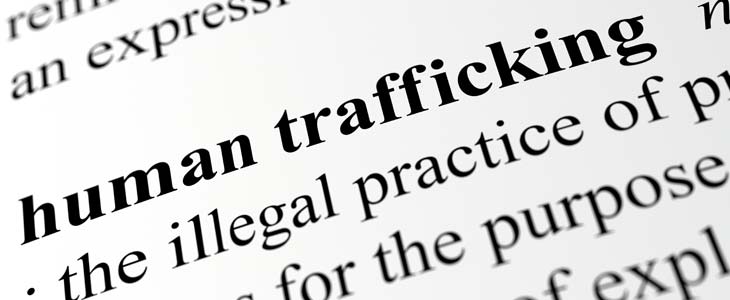
This article is the second part of a three-part series on the European Anti-Human Trafficking Legal and Policy Framework.
This article provides an overview of the extensive legal and policy instruments as well as the strategic documents and resources that address human trafficking at the European level by focusing on the EU’s Anti-trafficking Directive, Directive 2011/36/EU of the European Parliament and of the Council on Preventing and Combating Trafficking in Human Beings and Protecting its Victims, and Replacing Council Framework Decision 2002/629/JHA.
The EU’s Anti-trafficking Directive
Directive 2011/36EU1 is the fundamental legislative act that addresses human trafficking in the EU. It was adopted in 2011 and binds all EU member states, apart from Denmark, with a common goal and without dictating the means to achieve this goal. Therefore, it is the member states’ responsibility to devise their own national laws in order to address human trafficking effectively.
Directive 2011/36EU replaced the following three instruments:
- Council Directive 2004/81/EC on the residence permit issued to third-country nationals who are victims of trafficking in human beings or who have been the subject of an action to facilitate illegal immigration, who cooperate with the competent authorities:2 This instrument is the only one that is still in force among the three instruments that constituted the basis of Directive 2011/36EU.
- Council Framework Decision 2002/629/JHA on combating trafficking in human beings:3 This instrument aimed to introduce a framework of measures to be adopted at the European level. It is worth noting that human trafficking was only defined in terms of sexual exploitation and labour exploitation.
- Council Framework Decision 2001/220/JHA on the standing of victims in criminal proceedings:4 This instrument aimed to provide victims with minimum rights in criminal proceedings.
Directive 2011/36EU addresses human trafficking with a victim-centred and gender-specific approach as stated in Article 1 :
'This Directive establishes minimum rules concerning the definition of criminal offences and sanctions in the area of trafficking in human beings. It also introduces common provisions, taking into account the gender perspective, to strengthen the prevention of this crime and the protection of the victims thereof.'5
As a result of Article 23, Reporting, from Directive 2011/36EU; the European Commission submitted two transposition reports that accomplish the following,
'…assessing the extent to which the Member States have taken the necessary measures in order to comply with this Directive, including a description of action taken under Article 18(4), accompanied, if necessary, by legislative proposals [and] assessing the impact of existing national law, establishing as a criminal offence the use of services which are the objects of exploitation of trafficking in human beings, on the prevention of trafficking in human beings, accompanied, if necessary, by adequate proposals.'6
The following are the two reports:
- Report from the Commission to the European Parliament and the Council assessing the extent to which Member States have taken the necessary measures in order to comply with Directive 2011/36/EU on preventing and combating trafficking in human beings and protecting its victims in accordance with Article 23 (1)7
- Report from the Commission to the European Parliament and the Council assessing the impact of existing national law, establishing as a criminal offence the use of services which are the objects of exploitation of trafficking in human beings, on the prevention of trafficking in human beings, in accordance with Article 23 (2) of the Directive 2011/36/EU8
National Rapporteurs or Equivalent Mechanisms
Directive 2011/36EU requires European member states to establish national rapporteurs or equivalent mechanisms (NREMs) responsible for monitoring the implementation of anti-human trafficking policy at the national level.9 The role of national rapporteurs is described in Article 19:
'Member States shall take the necessary measures to establish national rapporteurs or equivalent mechanisms. The tasks of such mechanisms shall include the carrying out of assessments of trends in trafficking in human beings, the measuring of results of anti-trafficking actions, including the gathering of statistics in close cooperation with relevant civil society organizations active in this field, and reporting.'
In this regard, it is worth mentioning Myria Federal Migration Centre10 as an example, commonly known as Myria, the independent national rapporteur of Belgium. Myria analyses and evaluates the policy in the fight against human trafficking by publishing an independent public evaluation report every year that describes the evolution of the fight against human trafficking.
EU Anti-Trafficking Coordinator
Based on Article 20, the directive requires European member states and their NREMs to report to the EU Anti-Trafficking Coordinator (EU ATC).
'In order to contribute to a coordinated and consolidated Union strategy against trafficking in human beings, Member States shall facilitate the tasks of an anti-trafficking coordinator (ATC). In particular, Member States shall transmit to the ATC the information referred to in Article 19, on the basis of which the ATC shall contribute to reporting carried out by the Commission every two years on the progress made in the fight against trafficking in human beings.'
The EU ATC chairs bi-annual meetings with the NREMs and civil society to prepare the European Commission’s progress reports, which examine the progress made in the fight against human trafficking and highlight key challenges that the member states of the EU need to address as a priority. The following are two reports from the European Commission:
- First report on the progress made in the fight against trafficking in human beings (2016)11
- Second report on the progress made in the fight against trafficking in human beings (2018)12
These reports highlight an increasing number of individuals who were registered as victims of trafficking in Europe including women, men, girls and boys. However, due to the complexity in reporting, the actual number of victims is likely to be significantly higher. In addition, these reports note that children account for a sharply increasing part of the victims falling prey to traffickers. The reports also point out the links between human trafficking and other types of crimes, as well as the increasing use of the internet, social media and new technologies to recruit victims.
While the NREMs greatly contribute to the preparation of the European Commission’s progress reports, they also contribute to ‘Data collection on trafficking in human beings in the EU’,13 a report that presents a compilation of statistics at the European level on human trafficking. The EU ATC collects the data from the NREMs with the support of Eurostat. They also send questionnaires to member states requesting data.
The EU ATC is also responsible for monitoring the implementation of the ‘EU Strategy towards the Eradication of Trafficking in Human Beings 2012-2016’ and the ‘2017 Communication stepping up EU action’ to address trafficking in human beings.
Conclusion
It is worth recalling that human trafficking is a highly profitable source of economic gain that generates annual profits of 150 billion dollars.14 ‘Directive 2011/36EU’ is the fundamental legislative act that addresses human trafficking in the EU and establishes robust provisions to prevent and prosecute this crime for the protection, assistance and support of its victims. While it is the member states’ responsibility to devise their own national laws to address human trafficking effectively, ‘Directive 2011/36EU’ encourages cooperation between member states’ law enforcement authorities through cross-border cooperation, exchange of information and best practices as well as continued open dialogue between their police, judicial and financial authorities. In this regard, ‘Directive 2011/36EU’ highlights the importance for those responsible to investigate and prosecute human trafficking to have access to transaction monitoring and other financial investigation tools.
For more information on the European Commission’s work under the European legal and policy framework which aims at addressing human trafficking, visit the website Together Against Trafficking in Human Beings: https://ec.europa.eu/anti-trafficking/node/4598_en.
Jonathan Dupont, analyst, financial intelligence unit, Vilnius, Lithuania, jonathandupont@protonmail.com
- “Directive 2011/36/EU of the European Parliament and of the Council of 5 April 2011 on preventing and combating trafficking in human beings and protecting its victims, and replacing Council Framework Decision 2002/629/JHA,” EUR-Lex , 15 April 2011, https://eur-lex.europa.eu/eli/dir/2011/36/oj.
- “Council Directive 2004/81/EC of 29 April 2004 on the residence permit issued to third-country nationals who are victims of trafficking in human beings or who have been the subject of an action to facilitate illegal immigration, who cooperate with the competent authorities,” EUR-Lex, 29 April 2004, https://eur-lex.europa.eu/eli/dir/2004/81/oj.
- “2002/629/JHA: Council Framework Decision of 19 July 2002 on combating trafficking in human beings,” EUR-Lex, 19 July 2002, https://eur-lex.europa.eu/eli/dec_framw/2002/629/oj.
- “2001/220/JHA: Council Framework Decision of 15 March 2001 on the standing of victims in criminal proceedings,” EUR-Lex, 15 March 2001, https://eur-lex.europa.eu/eli/dec_framw/2001/220/oj.
- Ibid.
- “Directive 2011/36/EU of the European Parliament and of the Council of 5 April 2011 on preventing and combating trafficking in human beings and protecting its victims, and replacing Council Framework Decision 2002/629/JHA,” EUR-Lex, 15 April 2011, https://eur-lex.europa.eu/eli/dir/2011/36/oj.
- “Report from the commission to the European parliament and the council assessing the extent to which Member States have taken the necessary measures in order to comply with Directive 2011/36/EU on preventing and combating trafficking in human beings and protecting its victims in accordance with Article 23 (1),” European Commission, 2 December 2016, https://ec.europa.eu/anti-trafficking/sites/antitrafficking/files/report_on_member_states_compliance_with_directive_2011-36_en.pdf.
- “Report from the commission to the European Parliament and the Council assessing the impact of existing national law, establishing as a criminal offence the use of services which are the objects of exploitation of trafficking in human beings, on the prevention of trafficking in human beings, in accordance with Article 23 (2) of the Directive 2011/36/EU,” European Commission, 2 December 2016, https://ec.europa.eu/anti-trafficking/sites/antitrafficking/files/report_on_impact_of_national_legislation_related_to_thb_en.pdf.
- Member States, European Commission, https://ec.europa.eu/anti-trafficking/member-states_en.
- Myria, Federal Migration Centre, https://www.myria.be/fr.
- “First Report on the progress made in the fight against trafficking in human beings,” European Commission , 19 May 2016, https://ec.europa.eu/anti-trafficking/eu-policy/first-report-progress-made-fight-against-trafficking-human-beings-2016_en .
- “Second report on the progress made in the fight against trafficking in human beings,” European Commission, 4 December 2018, https://ec.europa.eu/anti-trafficking/eu-policy/second-report-on-the-progress-made-in-the-fight-against-trafficking-in-human-beings_en.
- “Data collection on trafficking in human beings in the EU,” European Commission, 2018, https://ec.europa.eu/home-affairs/sites/homeaffairs/files/what-we-do/policies/european-agenda-security/20181204_data-collection-study.pdf.
- “Profits and Poverty: The Economics of Forced Labour,” International Labor Organization , 20 May 2014, https://www.ilo.org/global/publications/ilo-bookstore/order-online/books/WCMS_243391/lang--en/index.htm.










